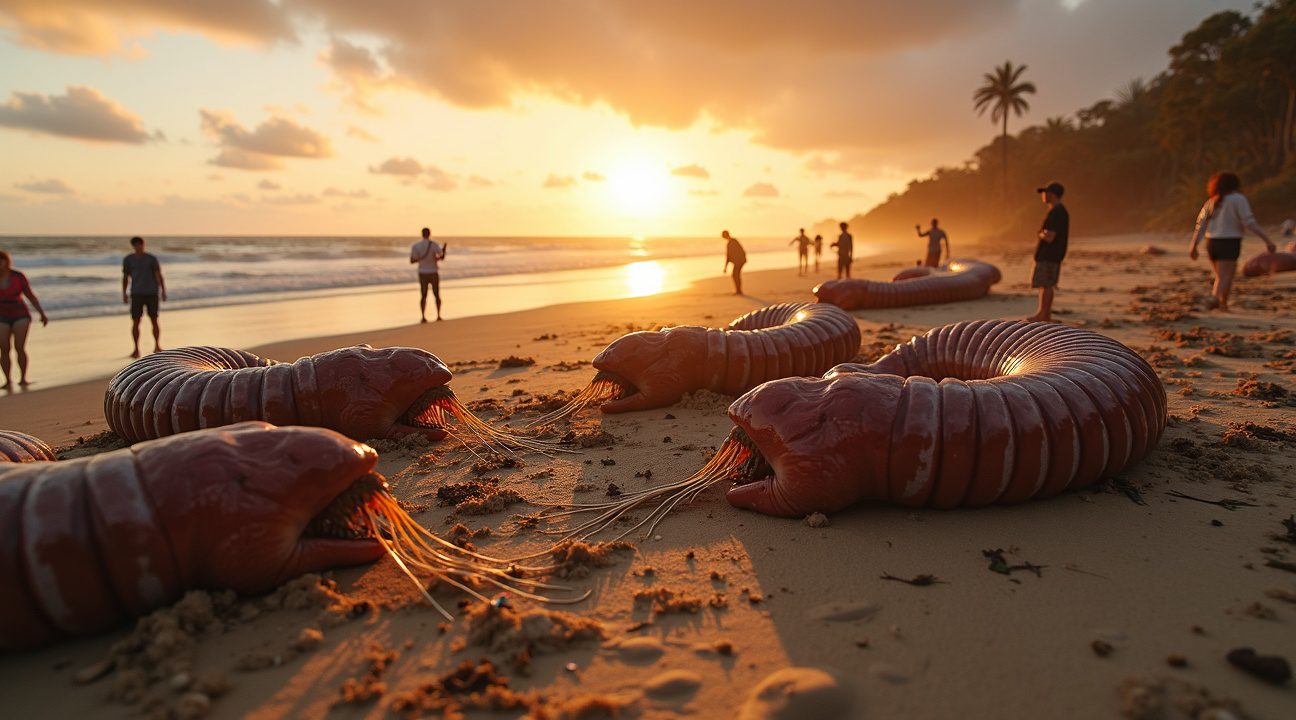Giant beach worms along Australian coastlines have captured public attention as videos showing these carnivorous creatures emerging from sand to feed on dead marine life circulate widely on social media.
These extraordinary polychaete worms, known scientifically as Australonuphis teres and Australonuphis parateres, can reach lengths of up to three metres, making them some of the largest marine worms found in coastal environments.
Key Takeaways
- Giant beach worms can grow up to three metres long and inhabit sandy beaches along Australia’s eastern and southeastern coastlines from Queensland to South Australia.
- These carnivorous predators emerge from underground burrows to feed on dead fish, octopus, and other marine debris using powerful jaws created for grasping and tearing flesh.
- The worms live permanently beneath popular swimming beaches, typically remaining hidden during daylight hours but emerging when attracted by the scent of fresh carrion.
- Australian fishermen prize these worms as premium bait, with sustainable hand-collection methods preventing overharvesting while supporting both recreational and commercial fishing.
- Despite their intimidating appearance and predatory feeding behavior, giant beach worms pose minimal threat to living humans and serve as essential scavengers in beach ecosystems.
To see these fascinating creatures in action, many social media users have shared videos showcasing their remarkable behaviors. For additional info and updates on giant beach worms, you can explore resources on websites such as ABC News Australia or CSIRO’s official site.
Three-Metre Carnivorous Worms Emerge from Australian Beaches to Feed
I’ve seen plenty of unsettling marine creatures throughout my years studying coastal ecosystems, but few inspire the visceral reaction that giant beach worms generate when they emerge from Australian sand. These extraordinary polychaete marine worms, scientifically known as Australonuphis teres and Australonuphis parateres, can reach staggering lengths of up to three metres, establishing them as some of the largest marine worms found along coastlines.
The sheer size of these carnivorous creatures becomes apparent when they breach the sandy surface during feeding. Picture a muscular, segmented body stretching nearly ten feet as it extends from hidden burrows beneath the beach. Each segment displays a grotesque beauty that simultaneously fascinates marine biologists and horrifies casual beachgoers who stumble upon them unexpectedly.
Giant beach worms inhabit a substantial stretch of Australia’s eastern and southeastern coastlines. I can find these remarkable creatures from Yeppoon in Queensland all the way down to Noarlunga in South Australia. This extensive range demonstrates their adaptability to various coastal environments, though they prefer sandy beaches where they can construct their elaborate burrow systems.
Feeding Behavior That Shocks Observers
The feeding spectacle that these worms create has sparked countless social media posts filled with horror and amazement. When dead fish, octopus, or other marine detritus washes ashore, the beach transforms into a feeding ground for these hidden predators. I watch as they detect the scent of decaying flesh through chemical receptors, then emerge with startling speed from their sandy homes.
The worm’s feeding apparatus appears almost alien in its efficiency. Distinctive jaws protrude from the head region, designed specifically for grasping and tearing chunks of meat from larger carcasses. These muscular structures can exert considerable force, allowing the worm to secure its meal before retreating back into the safety of its burrow.
Recent footage circulating online captures the dramatic moment when multiple worms simultaneously emerge to compete for a single food source. Similar to how giant squid footage captivates viewers with its otherworldly appearance, these beach worm videos generate intense reactions ranging from scientific curiosity to pure revulsion.
The timing of their emergence adds another layer of intrigue to their behavior. These polychaetes typically remain hidden during daylight hours, preferring to venture out during dawn, dusk, or nighttime hours when they feel most secure. However, the irresistible lure of fresh carrion can override their natural caution, leading to daylight appearances that shock unsuspecting beach visitors.
Beach fishermen have long recognized the value of these worms as premium bait, though collecting them requires specific techniques and considerable courage. The worms’ powerful jaws can deliver painful bites to unwary handlers, adding an element of danger to what might seem like simple bait gathering.
Environmental factors influence their feeding patterns significantly. Storm systems and rough seas often wash additional marine life onto shores, creating feast conditions that draw multiple worms from their burrows simultaneously. These events provide the most dramatic displays of their carnivorous nature, as dozens of massive worms can emerge across a single stretch of beach.
The horror factor intensifies when people realize these creatures live permanently beneath popular swimming beaches. Many visitors express shock upon learning that three-metre predators lurk just feet below the sand where children play and families gather. Despite their intimidating appearance and carnivorous diet, giant beach worms pose minimal threat to living humans, preferring their diet of deceased marine life.
News articles consistently highlight public reactions of disgust and amazement when these worms make appearances at busy beaches. The combination of their impressive size, alien appearance, and predatory feeding behavior creates a perfect storm of fascination that continues to generate viral content across social media platforms.
https://www.youtube.com/watch?v=e95NqtZ3oik

Muscular Predators with Powerful Jaws Hunt Beneath the Sand
I find Giant Beach Worms fascinating predators that showcase remarkable engineering beneath sandy surfaces. These creatures display impressive muscular bodies divided into hundreds of segments, creating a flexible yet powerful hunting machine that can extend up to three meters in length. Each segment works in harmony with the others, providing the strength and agility needed to navigate through dense sand while pursuing prey.
Anatomical Adaptations for Sand Hunting
The head region varies dramatically in coloration, ranging from reddish and greenish hues to striking pearly white appearances. When feeding time arrives, these worms extend their heads above the sand surface, revealing formidable jaws designed for grasping and securing food items. The bristles, known as setae, emerge from each body segment and function like tiny anchors, providing grip and leverage as the worm moves through its sandy environment.
Their burrow construction demonstrates sophisticated engineering skills, as they secrete mucus to bind sand particles temporarily. This process creates protective tubes that offer shelter and strategic hunting positions. Unlike permanent structures, these burrows can be modified and relocated as needed, giving the worms flexibility in their hunting territories.
Omnivorous Diet and Ecosystem Role
Giant Beach Worms display opportunistic feeding behaviors as true omnivores, consuming both plant and animal matter they encounter. While they’ll eat various seaweed and organic debris, fish frames and pipis represent their most attractive food sources. Their powerful jaws make quick work of decomposing animal remains, breaking down organic matter efficiently.
These muscular predators serve as essential scavengers in beach ecosystems, processing decomposing materials that might otherwise accumulate. Through their feeding activities, they contribute significantly to nutrient cycling, breaking down complex organic compounds into simpler forms that other organisms can utilize.
Bait collection often reveals their impressive hunting capabilities, as anglers regularly witness these worms emerging from sand to investigate potential food sources. Their strength becomes apparent when they resist capture, using their segmented body structure to anchor themselves deep within their burrows while extending only their heads to feed on surface offerings.
Where These Monster Worms Live and How They Reproduce
Beach worms establish their territories across Australia’s eastern coastline, stretching from South Australia through to Queensland. I’ve observed that the heaviest concentrations occur between Lakes Entrance in Victoria and Maroochydore in Queensland, where conditions align perfectly for their survival and growth.
These creatures thrive in the intertidal and subtidal zones of beaches, particularly favoring expansive, wave-exposed sandy stretches with gentle slopes. The irony isn’t lost that these same beaches attract thousands of human visitors seeking recreation. Beach worms actively seek out areas with long swash periods, where waves wash up the shore for extended durations, creating ideal hunting grounds for their carnivorous lifestyle.
The dynamic nature of beach habitats means these worms must constantly adapt to shifting sands and changing wave patterns. Sandy beaches with moderate slopes provide the perfect balance of water movement and sediment stability that allows them to construct their extensive burrow systems.
The Spawning Spectacle
Beach worm reproduction follows a fascinating pattern that begins when individuals reach approximately 40 centimeters in length. This maturity milestone occurs well before they achieve their maximum three-meter length, demonstrating their rapid growth capabilities. During summer months, mature worms engage in synchronized spawning events through external fertilization.
The reproductive process involves several key stages:
- Mature adults release gametes simultaneously into the water column
- Fertilized eggs develop into pelagic larvae that drift in ocean currents
- Larvae feed extensively on phytoplankton during their planktonic phase
- Young worms settle into sandy substrates when they reach approximately 3 centimeters
- Juvenile worms begin their rapid growth phase toward adult size
Research indicates that Australonuphis parateres produces significantly more eggs compared to related genera, giving them a reproductive advantage in competitive beach environments. This prolific egg production helps explain their successful colonization of suitable beaches along Australia’s coast.
After spawning, the pelagic larvae spend weeks drifting in ocean currents, feeding on microscopic phytoplankton. This planktonic stage allows for wide dispersal, enabling beach worms to colonize new beaches and maintain genetic diversity across their range. The larvae eventually settle into sandy sediments where they begin their transformation into burrowing predators.
Young beach worms demonstrate remarkable growth rates once they establish their burrows. From their initial 3-centimeter settlement size, they rapidly expand their body length while developing the powerful jaws and muscular bodies that make them such effective predators. The combination of abundant food sources in beach environments and their efficient metabolisms allows for this accelerated development.
Beach worm habitats remain in constant flux due to tidal action, storm events, and seasonal changes. Despite these challenges, established populations show remarkable resilience. Their burrowing behavior provides protection from environmental fluctuations while positioning them perfectly to ambush prey items washed up by waves.
The success of beach worm populations depends heavily on beach morphology and wave energy. Beaches with consistent wave action bring regular food supplies while maintaining the sandy conditions these worms require. Coastal dynamics play a crucial role in determining which beaches can support thriving populations versus those that remain unsuitable.
Understanding beach worm distribution patterns helps explain why beachgoers encounter them more frequently at certain locations. Popular swimming beaches often provide ideal conditions for both human recreation and beach worm populations, creating inevitable interactions between people and these impressive marine predators.

Fishermen Prize These Giant Worms as Premium Bait Despite Collection Challenges
Australian fishermen recognize Giant Beach Worms as premium bait, ranking them second only to pipis for both recreational and commercial fishing applications. These massive marine worms command respect in fishing circles due to their effectiveness in attracting larger fish species.
Collection Methods and Fishing Techniques
Harvesting these impressive creatures requires specific techniques that exploit their natural feeding behaviors. Collectors typically use fish frames or pipis as bait to lure the worms from their sandy burrows to the surface. Once a worm responds to the bait, fishers must employ hand extraction methods to carefully pull the creature from the sand without breaking it.
The collection process demands considerable skill and patience. Fishers must remain motionless while waiting for worms to emerge, then execute precise movements to secure their catch. This labor-intensive approach naturally limits the number of worms that can be harvested, which contributes to the fishery’s sustainable nature.
Successful collection requires understanding worm behavior patterns and optimal timing. Beach worms are more active during specific tidal conditions and times of day, making collection a strategic endeavor rather than a simple gathering activity.
Sustainability and Regional Variations
The Giant Beach Worm fishery maintains sustainable status primarily due to the significant effort required for hand gathering. Unlike mechanical harvesting methods used for other marine resources, the manual collection process creates natural limits on extraction rates. Little evidence suggests widespread population decline across their range, though localized depletion can occur in heavily fished areas.
Regional differences in harvest pressure present varying sustainability challenges. Queensland experiences harvest rates three times higher than New South Wales, creating potential risks for local resource depletion. This disparity highlights the importance of monitoring regional collection activities to prevent overharvesting in specific locations.
Recreational overharvesting poses the greatest threat to local populations, particularly in easily accessible beach areas near urban centers. Popular fishing spots can experience temporary worm shortages when collection pressure exceeds natural reproduction rates. However, the species’ ability to recover relatively quickly helps maintain overall population stability.
The labor-intensive nature of collection provides built-in conservation benefits. Unlike other marine creatures that face industrial harvesting pressure, beach worms benefit from collection methods that require individual effort and skill. Each worm must be individually located, baited, and extracted by hand, preventing mass harvesting operations.
Commercial collectors often develop specialized knowledge about optimal collection sites and techniques, creating informal stewardship of productive areas. These experienced harvesters understand that maintaining healthy worm populations ensures continued availability of this valuable bait resource.
The high demand for these creatures as fishing bait reflects their proven effectiveness in catching target fish species. Their size and movement patterns make them irresistible to many predatory fish, justifying the effort required for collection. Professional fishing guides and charter operators frequently rely on beach worms for successful fishing expeditions.
Collection regulations vary by state, with some areas implementing size limits or seasonal restrictions to protect breeding populations. These management measures help balance commercial and recreational demand with conservation needs. The fishery’s sustainable assessment reflects both the natural limitations of hand collection and the implementation of appropriate management strategies.
Despite their fearsome appearance and carnivorous nature, these giants represent a valuable renewable resource when harvested responsibly. The combination of natural collection limitations and targeted management approaches supports long-term availability for Australia’s fishing community while maintaining healthy wild populations.
How Giant Beach Worms Compare to Other Marine Worms
Giant beach worms stand as true leviathans among their marine cousins, reaching impressive lengths that can exceed 2.5 metres and occasionally stretch up to 3 metres. I find their sheer size remarkable when considering that most beachgoers expect to encounter much smaller creatures during their coastal adventures.
Size Disparities Among Marine Worm Species
When comparing these massive predators to other common beach worms, the size difference becomes immediately apparent. Consider the Lugworm (Arenicola marina), a species frequently found on sandy shores that reaches only 12–20 cm in length—making giant beach worms roughly fifteen times longer. This dramatic size difference explains why encountering one of these massive marine creatures can cause such alarm among swimmers and fishers.
Most polychaete worms remain relatively modest in size, with only a small minority achieving lengths comparable to giant beach worms. I notice that even among the larger marine worm species, few display the same aggressive predatory behavior that makes these giants particularly unsettling to observe. Their carnivorous appetite sets them apart from the filter-feeding or detritus-consuming habits of most beach-dwelling worms.
The intimidating presence of these creatures becomes even more pronounced when considering their hunting capabilities. Unlike smaller worms that burrow peacefully through sand, giant beach worms actively pursue prey with surprising speed and determination. Their muscular bodies can contract and extend rapidly, allowing them to strike at small fish, crustaceans, and other marine life with considerable force.
Beach fauna typically consists of creatures measuring just centimeters in length, making the appearance of a three-metre worm genuinely shocking for unsuspecting coastal visitors. I’ve observed that their size alone generates fascination among marine biology enthusiasts while simultaneously causing significant alarm among casual beachgoers. The contrast between expectations and reality creates an almost surreal encounter that challenges people’s assumptions about typical beach wildlife.
These remarkable dimensions place giant beach worms among the largest invertebrates found in shallow coastal waters. Their impressive length, combined with their predatory nature, establishes them as apex predators within their specific habitat zone. This combination of size and hunting behavior distinguishes them dramatically from the peaceful, smaller worms that most people associate with beach environments, explaining why encounters with these extraordinary marine animals generate such strong reactions from those who witness them in their natural habitat.

Sources:
Australian Museum, “Giant Beach Worm”
Queensland Marine Worm Identification Guide, “Common marine bait worms”
NSW Department of Primary Industries, “Beachworms – NSW Stock Status Summary 2021”
NSW Department of Primary Industries, “Beach Worm”
MarineBio Conservation Society, “Worms (Marine)”
Wildlife Trusts, “Lugworm”
GBRI Student Project 2016, Fiona Ryan, “Australonuphis parateres”


